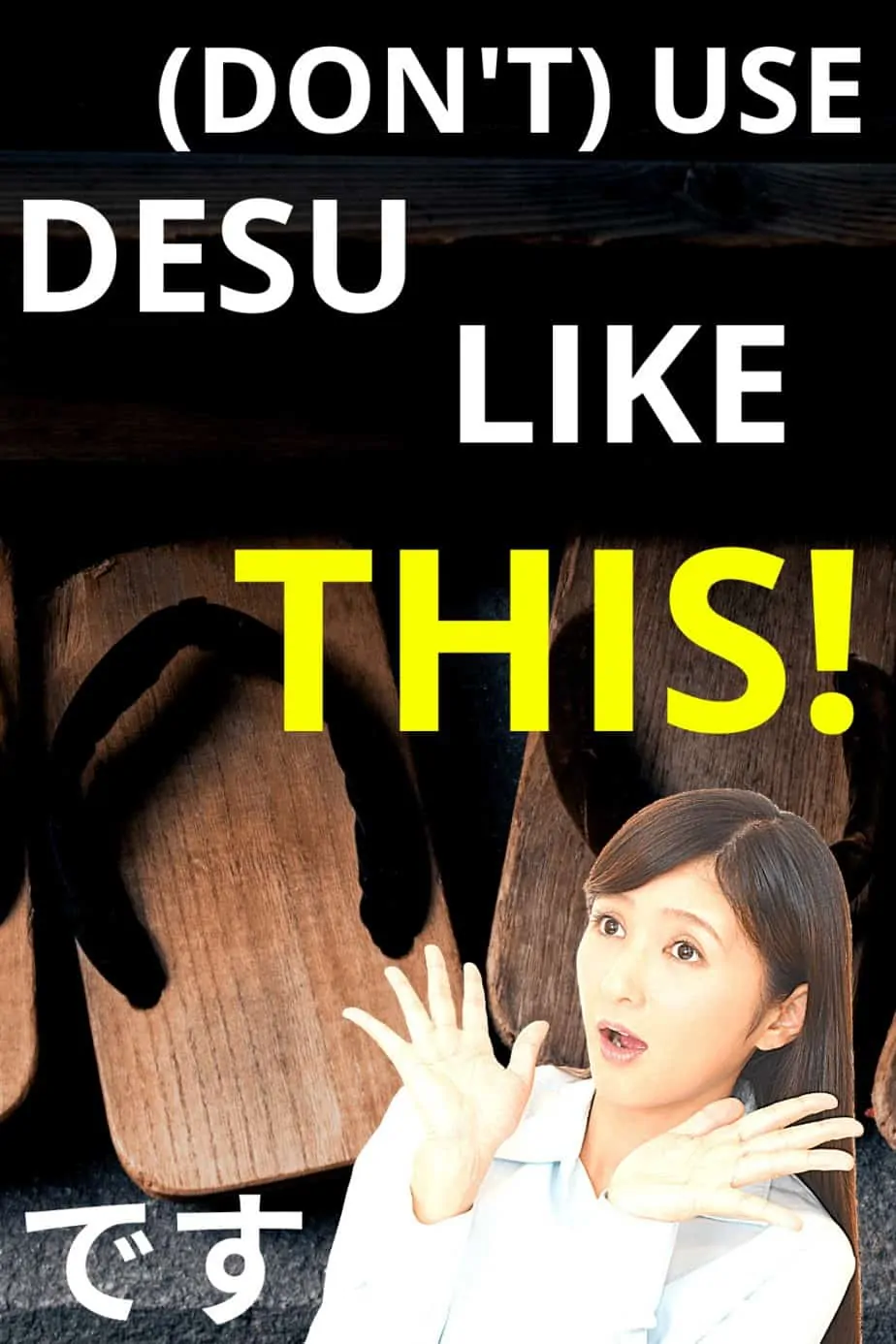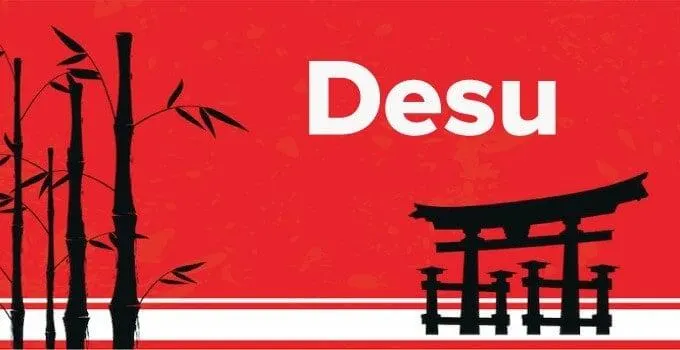です (desu) is one of the very first things you learn in Japanese. If you didn’t see it for the first time in a text book, you noticed it in anime, attaching itself to the end of sentences like a period. It’s everywhere. And how could it not be? It’s the foundation of being itself.
In this article, I’m going to take you step-by-step through every single aspect of this word (well, cupola, well, … sigh. We’ll get to it later). How to use it, how to pronounce it, and where it came from, plus a bunch of details in between. Way more than you imagined!

What does desu mean?
です (desu) is usually pronounced “des” and is a verb—specifically a copula—placed at (or very near) the end of a sentence to state that something “is,” or “exists.” Basically, “desu” creates a declaration. “Ka” can be added to make it a question.
What’s it like? The easy part
“Desu” is written in kana, the phonetic sorta-alphabet (really a syllabary) used to write parts of Japanese (you read that right—only parts of Japanese are written in Kana. A total of 4—count ‘em, four—different types of writing are used in Japanese).
Most often you’ll see it written in hiragana as です (de-su). Occasionally, you might see it written in katakana as デス. When written in katakana it can mean something different, but we’ll get to that later.
Since it’s written as “desu” you might think you would pronounce it as “deh-soo,” but that’s not the case. For all intents and purposes, it’s pronounced “des” (dehs).
How do you use it? The Harder Part
So, we’re going to have to learn a little English to continue learning Japanese. Unless you’re a grammar nerd (or were a particularly diligent student), you’ve never heard the term “copula.”
The copula has a pretty simple job. It connects a noun to a predicate, aka the verb giving information about the sentence. In Japanese, the desu copula is its own predicate.
In its most simple form, we use desu to create a declaration. “X is Y.” Or, “X is.” This usually comes in the form of XはYです. We can drop the はY part to make the declarative Xです. We can also drop the です and retain the meaning, but the assertive feeling of the statement is dampened.
Let’s try some examples to illustrate:
ペンは青いです。
Pen wa aoi desu.
The pen is blue.
ペンです。
Pen desu.
It’s a pen. (They’re pens.)
青いです。
Aoi desu.
It’s blue.
You may have noticed the parenthetical on the second example. Japanese doesn’t distinguish between “is” and “are.” That’s something to keep in mind going forward.
Time for Tense
Tense in Japanese is a sticky situation. For present and future, you’re going largely on context. For past tense, luckily, we get a nice, simple conjugation.
For the past tense, desu becomes deshita (です→でした). You use it exactly the same way.
There’s another layer to this tense thing, though. To negate a verb, there’s no word you use. In fact, Japanese verbs come with their very own conjugations of each tense to create negation. In this case we get:
ではありません (written, present negation)
dewaarimasen
じゃありません (spoken, present negation)
jaarimasen
ではないです (written, present, stronger negation)
dewanai-desu
じゃないです (spoken, present, stronger negation)
janai-desu
Alright, now we just have to take these and make the negations past tense as well.
ではありませんでした (written, past negation)
dewaarimasen-deshita
じゃありませんでした (spoken, past negation)
jaarimasen-deshita
ではなかったです (written, past, stronger negation)
dewanakatta-desu
じゃなかったです (spoken, past, stronger negation)
janakatta-desu
And all of that? That’s just the polite form.
Down to Earth: the casual (plain) forms of desu
Desu is the polite form of the copula. If we want to bring things down a level to the plain form, we do the following:
です → だ
desu → da
じゃないです → じゃない
janaidesu → janai
でした → だった
deshita → datta
じゃなかったです → じゃなかった
janakatta-desu → janakatta
To make a super-colloquial version of desu, use ssu (です→ っす).
Cranking it up: humble desu and beyond
If you’re talking to the CEO, a customer, or perhaps your s.o.’s parents, you might want to make your speech a little more formal. To do this, we turn desu into a few different things. First, let’s look at how to speak humbly about ourselves:
です → でございます
desu → degozaimasu
ではありません → ではございません
dewaarimasen → dewagozaimasen
でした → でございました
deshita → degozaimashita
ではありませんでした → ではございませんでした
dewaarimasen-deshita → dewagozaimasen-deshita
If you get sent back in time to fuedal Japan and need to go undercover as a samurai, you can always break out “degozaru” (でござる).
If we want to go the other direction and speak “honorifically” about someone else ( e.g. “He is the CEO”), then we use these:
です → でいらっしゃいます
desu → deirasshaimasu
ではありません → でいらっしゃいません
dewaarimasen → deirasshaimasen
でした → でいらっしゃいました
deshita → deirasshaimashita
ではありませんでした → でいらっしゃいませんでした
dewaarimasen-deshita → deirasshaimasen-deshita
Regional Desu
Of course, because this is Japan we’re talking about, nothing’s easy. If you travel to the Kansai region (think Osaka, Kyoto, and Kobe) then desu becomes ya (です→ や). Keep going west and it becomes ja (じゃ). Further south, cha (ちゃ) gets added in. Some areas use all of these, or a few, or… Uh, just ask a local when you arrive.
And if you’re talking to an old person, note that they tend to say ja instead of desu.
Bill & Ted’s Nihongo Adventure
If you get sent back in time to feudal Japan and need to go undercover as a samurai, you can always break out “degozaru” (でござる) instead of desu for the humble form.
Beyond that, in classical Japanese you’ll see niari (にあり), nari (なり), and tari (たり). I’m not going to go into a full breakdown of these because:
A) My grasp of regular Japanese is slippery enough without diving into the wild world of Classical Japanese.
B) Anyone who needs to know these will probably have a big, smart textbook in front of them when they use ‘em.
Where did desu come from?
Ya’ll know I love giving you a good origin story for these words. Unfortunately, the etymology on this one is neither concrete, nor particularly interesting.
Desu seems to have many competing ancestors, namely the contracted forms of either de-sou, de-arimasu, de-aru, de-ohasu, de-gozaimasu, de-suru, or de-sourou. Of those, only the first two seem to have much backing behind them.
Desu first shows up during the Muromachi period (1337-1573), the time immediately before the world-famous Sengoku and Edo periods that feature everyone’s favorite samurai stories. The word is used at the time primarily in Kyogen and Noh plays as a way to declare the entrance of daimyo, high officials, monks, and demons. Later, it was used in daily speech by “ruffians and prostitutes.”
It wasn’t until the end of the Edo period (around the mid-19th century) that the word began to resemble its current usage. After the Meiji period ended, desu began to be used widely.
Changing desu
You’ve probably noticed that desu doesn’t always (or even usually) come alone. There’s typically all these extra sounds tacked to the end. “Ka” (か), “ne” (ね), and “yo” (よ) being the most common you probably hear. So, let’s go through them.
Desuka (ですか) turns the declaration into a question. ”Ka” basically acts like a verbal question mark here.
Desuyo (ですよ) adds emphasis to the declaration. In this case, it’s like an exclamation point.
Desune (ですね) adds something like, “isn’t it?” to the end.
The other desu
Remember how I mentioned the two different syllabic writing systems? Well, while desu can be written as either です or デス, most commonly when it’s written as デス it means “death.”
This is a case of Japanese using katakana to Japanify an English loan word. If you think about it, “des” can sound a bit like “death” if the “th” sound isn’t made properly. That’s where it comes from.
This word, as far as I can tell, is only used when writing things that come from English, or to give a sort of English flair.
So, for example, “death metal” is written as “desu-metaru” or デスメタル.
Usually, the idea of “death” is said as “shi” and written as し or 死.
That’s all folks
There you have it, an utterly comprehensive overview of the word “desu.” I hope I cleared up all the possibly mysteries of this deceptively un-simple word.
Related Questions
What is a kawaii desu?
“Kawaii” means something like “cute” (it’s more nuanced than that—a lot more—but it’s a perfectly fine shorthand for now). And desu, as described above, means “is.” So, it means, “It’s cute.”
What is kawai desu ne?
Following from the above question, this just means, “It’s cute, isn’t it?”
Do you say the u in desu?
Nope. Desu sounds like “dess.”
What does desu mean after a name?
You’re just stating a name in these cases. So, you could use it to introduce yourself.
“Bob desu.”
“I’m Bob.”
Note, that this is somewhat casual—not good for introducing yourself to a new boss, probably.
You could also introduce someone else, relying on some context to indicate that.
“Sarah desu.”
“This is Sarah.”
And you can use it for other names as well. For example, saying the name of the store you’re in.
“Uniqlo desu.”
“This is Uniqlo.”
Is desu a particle?
No, it’s not a particle. It’s a sort of verb—a copula. Particles can’t be changed and are just used to show how things connect grammatically. Desu can be conjugated and makes a direct statement about things.
What does desu mean in 4chan?
Desu got used as a spam attack on 4chan many years ago by writing the word over and over and over. It’s also used with some frequency by anime fans by placing desu at the end of their English sentences. A rather… strange quirk, to be sure. It’s now used in memes in general for funny effect or to mock fans of Japanese media.

Hey fellow Linguaholics! It’s me, Marcel. I am the proud owner of linguaholic.com. Languages have always been my passion and I have studied Linguistics, Computational Linguistics and Sinology at the University of Zurich. It is my utmost pleasure to share with all of you guys what I know about languages and linguistics in general.

